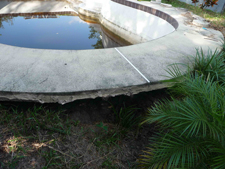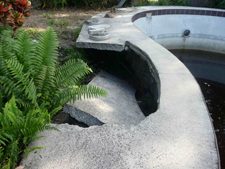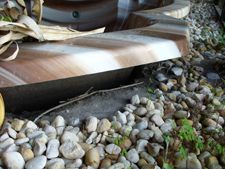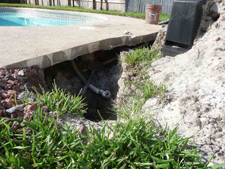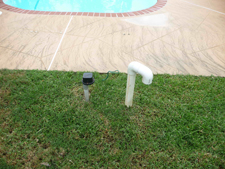Introduction
Hydrostatic forces from elevated ground water have the potential to cause an in-ground swimming pool to pop out of the ground and create significant damage. When soils are saturated with water, in-ground pools are susceptible to float out of the ground after they are fully or partially emptied of water. This is because of the potential for the hydrostatic force of water pushing from below to overcome the weight of the buried pool and other restraining forces, such as friction between the pool walls and the ground. If the hydrostatic uplift force exceeds the restraining forces, the pool will move upward, causing damage. This is commonly called “pool popping”, which happens every year somewhere in Florida, mostly during the rainy season.
Background
When an object is submerged in a liquid, the upward or buoyancy force on the object is equal to the weight of the liquid displaced by the object. The buoyancy force is opposed by the total weight of the object. The same principle applies to a swimming pool built in soil saturated with water. Under normal conditions, the pool is filled with water. The weight of the water, weight of the pool, and the restraining effects, such as friction of the soil on the pool walls, counteract the buoyancy force on the pool, and the pool remains in place. However, if the pool is empty or even partially empty when the surrounding soil is saturated, the hydrostatic uplift force can cause the pool to float or “pop” out of the ground. This usually results in significant cracks and other damage to the pool and the surrounding components, which may include concrete walkways, wood decks, supply and drain lines, lighting and other finishes. Pool pop failures are often more severe at the deep end of the pool.
Fiberglass Pools Shells
Fiberglass shells are susceptible to popping from hydrostatic uplift due to their relatively low weight. When the pool is full, water in the pool opposes the lateral forces of the soil and water surrounding the pool shell. When the pool is emptied, this opposing hydrostatic force is not present, and the weight of soil and water outside the shell may cause the side walls of a fiberglass or vinyl pool liner to deflect inward. Concrete pool walls are typically 4” to 6” thick and reinforced with steel. This is obviously a much heavier structure than a fiberglass pool. However, concrete pools are still susceptible to significant upward hydrostatic thrust. This office has inspected many hydrostatic failures of concrete pools. Lateral deflection of the side walls of concrete pools is not common due to the strength and stiffness of the reinforced concrete walls. Hydrostatic valves and drain pipes are sometimes used to help prevent a hydrostatic failure. A hydrostatic relief or check valve is often placed in the main pool drain line. The purpose of this valve is to equalize the pressure between the water beneath the pool and the water at the bottom of the pool. Should the water pressure beneath the pool substantially exceed the water pressure at the bottom of the pool, the valve is designed to open, allowing water beneath the pool to flow into the pool bottom. A murky or dark cloud near the pool drain may indicate recent relief valve activity. Some problems with these valves include the valve being stuck open or failure of the valve to open to relieve high water pressure beneath the pool. In the case of the latter, the high water pressure may cause the pool to pop.
Well Points
Well points are sometimes used for groundwater control. These consist of a plumbing pipe installed in cohesionless soil (sand) or gravel beneath or beside the pool shell. The well point is used to draw ground water out from beneath the pool before it is emptied, reducing the potential hydrostatic uplift pressure to prevent the pool from popping.
Conclusion
Hydrostatic forces may cause in-ground pools to float or pop out of the ground and cause damage to the shell and surrounding components. A pool that has “popped” out of the ground from hydrostatic failure should not be refilled with water. If this is done the pool will likely crack further and or crack across the bottom. If this occurs the potential for salvaging the pool will likely be lost. A pool that is only slightly popped and not otherwise significantly damaged may be salvageable by cutting the top walls, pressure grouting under the pool to fill voids, and re-backfilling around the pool. An experienced pool maintenance contractor should be consulted before emptying an in-ground swimming pool. A Professional Engineer, structural discipline, should be consulted if a problem occurs and a pool “pops” out of the ground before further action is taken in an attempt to correct the structural problem. The pool should not be refilled with water until this is done.
